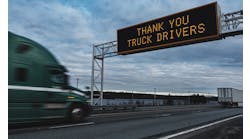Hardly a day goes by without the driver shortage coming up in conversation. It remains the top industry concern, according to the American Transportation Research Institute’s annual survey.
Yet, according to a new report from the U.S. Department of Labor, it is all just another case of fake news.
The Bureau of Labor Statistics’ latest monthly labor review begins by claiming "the trade press covering the U.S. trucking industry often portrays the U.S. labor market for truck drivers as dysfunctional, citing persistent driver shortages and high levels of firm-level turnover and predicting significant resulting constraints on the supply of motor freight services."
BLS’ report proceeds to pick apart many of the common complaints surrounding the driver shortage, suggesting that statistics indicate the industry is not all that different from other blue-collar occupations.
While longhaul truckload sector has experienced "high and persistent turnover rates for decades, the overall picture is consistent with a market in which labor supply responds to increasing labor demand over time, and a deeper look does not find evidence of a secular shortage."
It found that drivers with higher earnings and working hours are less likely to leave their existing positions - a statement that on its surface seems quite logical.
"As a whole, the market for truck drivers appears to work as well as any other blue-collar labor market, and while it tends to be 'tight,' it imposes no constraints on entry into (or exit from) the occupation," BLS said. "There is thus no reason to think that, given sufficient time, driver supply should fail to respond to price signals in the standard way.”
In the end, BLS concludes "there is not, and has never been, a serious shortage of people willing to work as truck drivers."
This report was published online around the same time I was at the Truckload Carriers Association’s annual conference. The event in Las Vegas featured fleet executives and consultants engaged in frank discussions regarding what it truly takes to attract drivers.
For example, Lana Batts, co-president of Driver iQ, shared results from a survey of recruiters that found a majority believe $75,000 in annual compensation is required to attract new drivers. The survey also found that 25% said the magic level to attract drivers is $100,000.
That is quite a difference from the current average salary of $55,000 a year that American Trucking Associations (ATA) cites as an immediate, barrier-free path to the middle class.
Eric Fuller, president and CEO of U.S. Xpress Enterprises, did not address an exact salary level, but estimated new truck drivers will demand a 25% to 30% pay premium over other jobs that allow them to be at home every night. In the past, Fuller said, that was premium was more in the range of 10%-15%.
Another interesting statistics from Driver iQ came from the question of hiring interstate drivers below the age of 21, based on the conditions laid out in the DRIVE-Safe Act.
Back in 2012, 30% of fleets said they would even consider hiring entry level drivers. That figure has since soared to 65%, which Batts said showed a “fundamental shift” in industry’s thinking. However, she suggested the reality is that a much lower percentage appears seriously ready to consider taking this step within their own fleet.
Fuller agreed, admitting he was “not fully on board” with those under the age of 21 driving heavy trucks. It is a complex job and “I don’t think this is the right way to go in the long term,” he said.
Thomas Grojean, chairman of Hirschbach Motor Lines, said he was in the “same camp” as Fuller, and was concerned about being a “guinea pig” when it comes to these drivers.
There were also mixed data regarding the popularity and cost effectiveness of recruiting programs specifically targeting groups such as military veterans and women.
Instead, the greatest success comes from referrals of existing drivers. These drivers already have come to understand the culture of their companies, and generally are having their expectations met, whether that is pay, home time, or overall working environment.
According to Stay Metrics, new drivers’ expectations are clearly not being met. Data show of the more than 3,000 drivers hired back in January 2018 among 89 carriers, only about 40% were still with them at the start of this year.
Tim Hindes, CEO of co-founder of Stay Metrics, told me at TCA that he recommends to fleets they focus needs to be on “drivers first - not customers, not shareholders. They get taken care of in the end.”
“Anybody not laser focused on making the driver experience at your company the best it’s ever been… fire them,” he said.
Regardless of whether there is actually an industrywide shortage of drivers or not, that seems like worthwhile advice to ensure your fleet tries to stay ahead.



